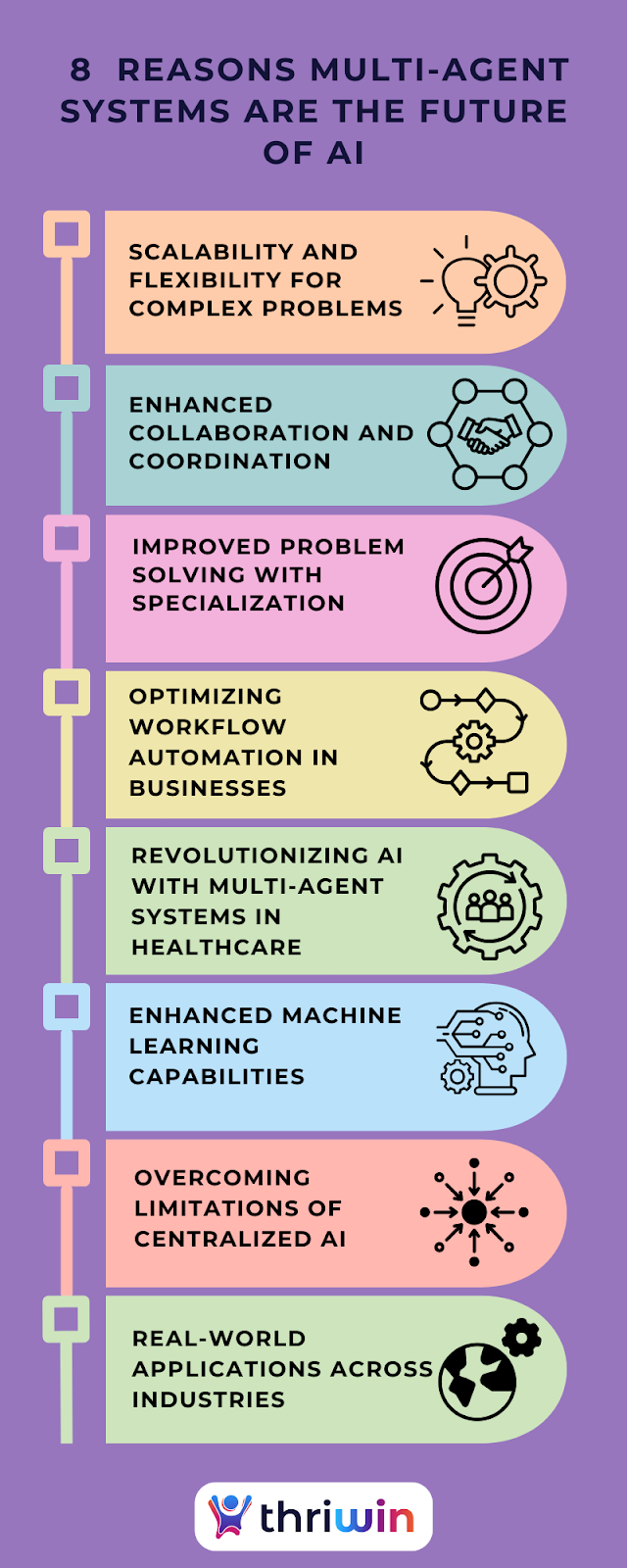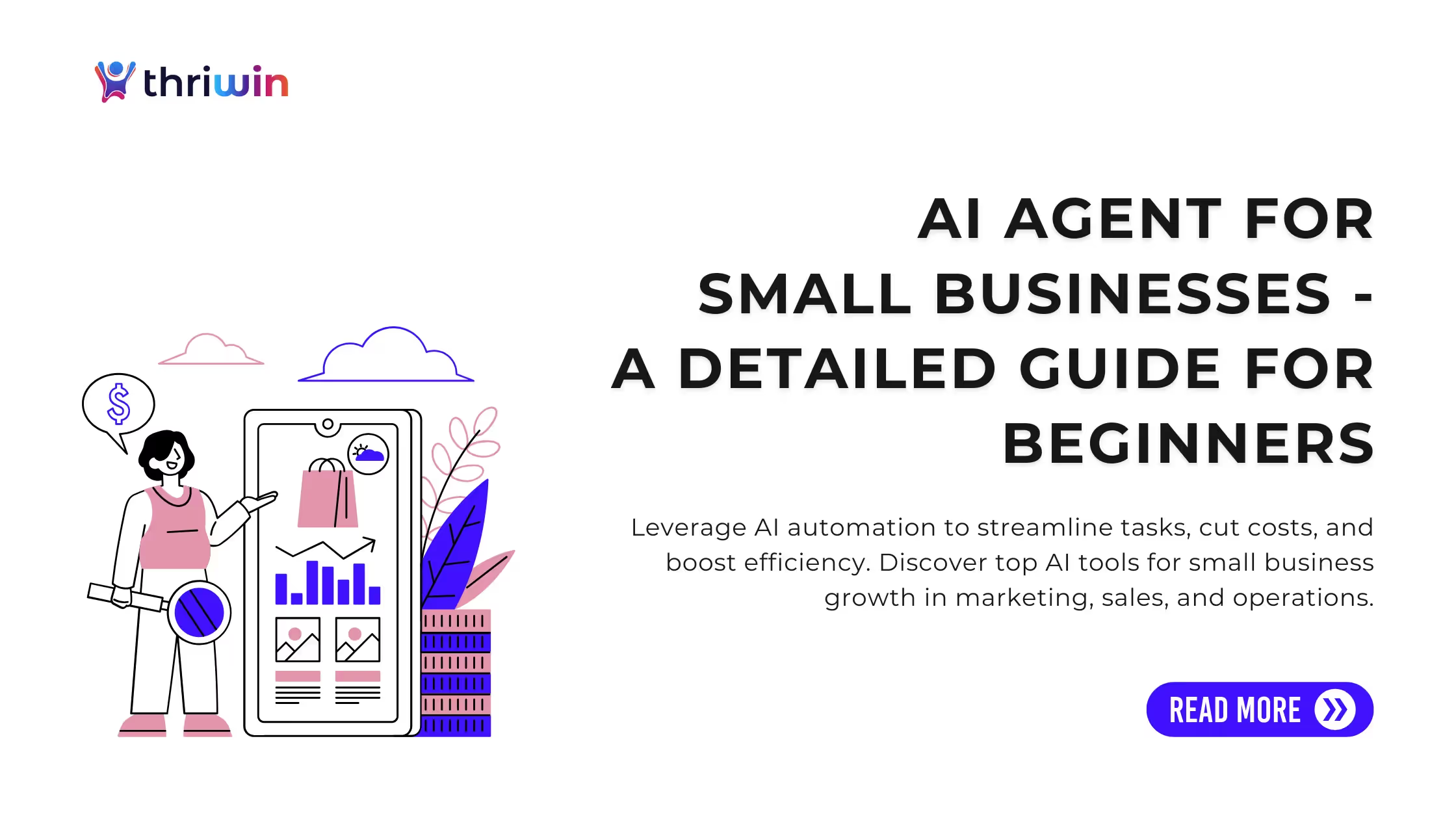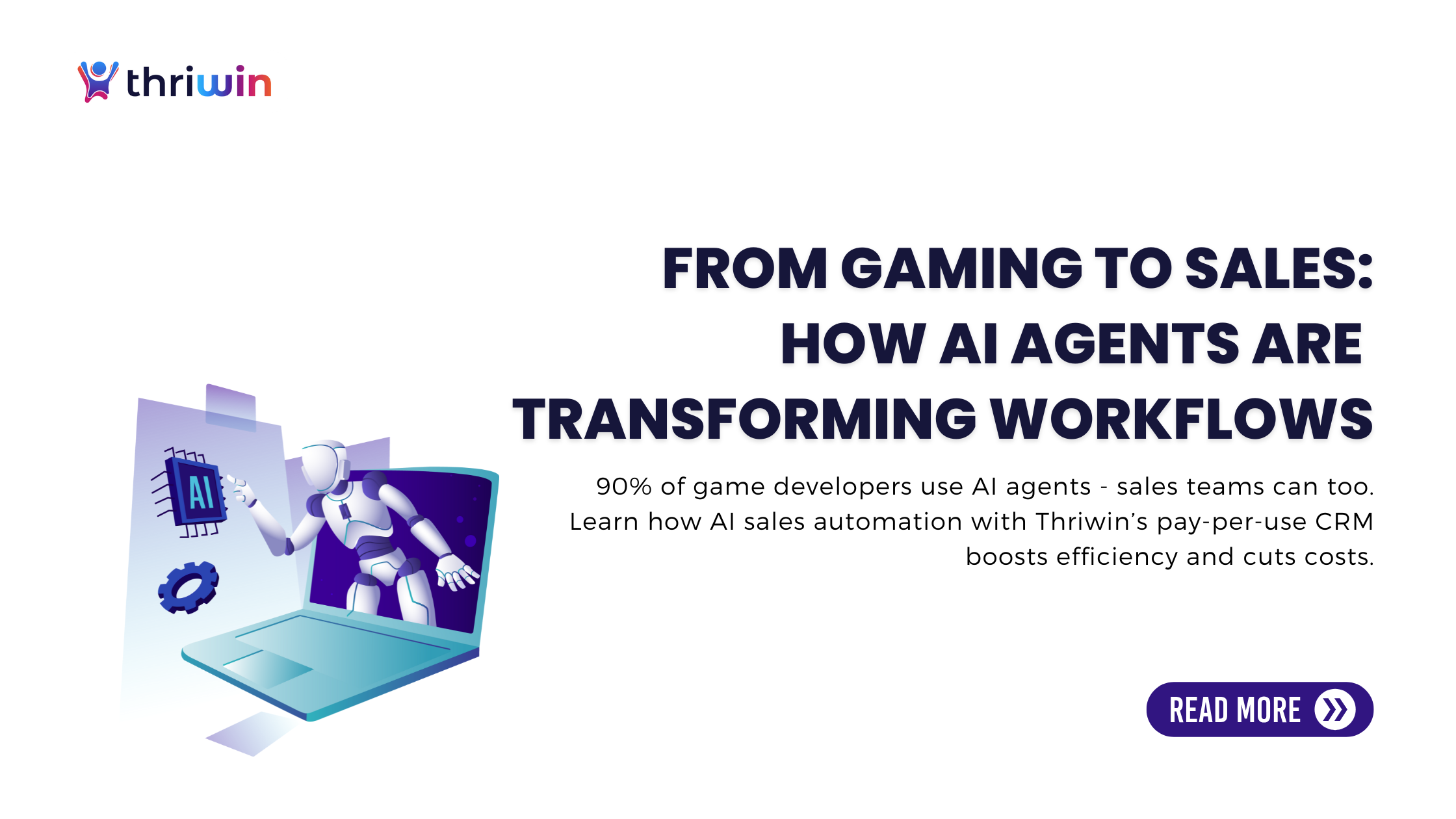As organizations increasingly rely on AI-driven solutions to optimize operations and tackle complex challenges, the limitations of traditional single-agent systems have become apparent. Single-agent AI architectures often require assistance in scaling effectively, adapting to dynamic environments, and managing large, multifaceted datasets in real-time. These constraints can lead to inefficiencies and missed opportunities in fast-paced finance, healthcare, and logistics industries.
Enter Multi-Agent Systems (MAS), a transformative approach to AI that overcomes the inherent limitations of single-agent models. MAS enables more scalable, flexible, and collaborative problem-solving capabilities by distributing decision-making across multiple autonomous agents. This distributed model allows organisations to process large volumes of data, enhance operational efficiency, and facilitate adaptive responses to rapidly changing conditions.
In this article, we’ll explore the key reasons why Multi-Agent Systems are set to drive the next wave of innovation in AI. From improving scalability and coordination to optimizing business processes and enhancing machine learning capabilities, MAS is uniquely positioned to meet the demands of complex, data-rich environments and offer strategic advantages to forward-thinking organizations.
The Rise of AI and the Need for Multi-Agent Systems
As AI systems evolve, the limitations of single-agent models are becoming apparent. These systems operate under a centralised decision-making model, where all actions and choices originate from a single entity. While adequate for more straightforward tasks, this approach struggles with larger, more complex environments where agility, flexibility, and scalability are key.
Enter multi-agent systems—a paradigm shift in AI architecture. With multiple agents working together, each responsible for specific tasks, these systems can handle larger datasets, more intricate decision-making, and rapidly changing conditions. MAS is positioned to lead the way as industries such as healthcare, finance, autonomous vehicles, and robotics transition to increasingly complex operations.
What Are Multi-Agent Systems?
A Multi-Agent System (MAS) comprises multiple independent agents that interact with each other and their environment. Each agent is designed to perform specific tasks autonomously, but they collaborate and share information to achieve a common goal. Depending on the system's design, the interaction between agents can be cooperative, competitive, or a combination of both.
These agents are often designed with specialized capabilities, allowing them to tackle diverse tasks within a larger project. The combined effort of several agents enables more efficient decision-making and problem-solving compared to a single-agent setup.
How Multi-Agent Systems Differ from Single-Agent Systems
Here’s a detailed comparison between Multi-Agent Systems (MAS) and Single-Agent Systems:

Why Multi-Agent Systems Are Set to Shape the Future of AI

1. Scalability and Flexibility for Complex Problems
Handling Large-Scale Data Efficiently
Multi-agent systems offer significant scalability advantages over single-agent systems. MAS can handle massive amounts of data by distributing tasks among several agents without becoming overwhelmed. Each agent processes a portion of the data in parallel, enabling faster processing times and more accurate results. This is particularly useful for industries such as finance, where data is generated rapidly and requires immediate processing for informed decision-making.
Adaptability in Dynamic Environments
One key strength of multi-agent systems is their adaptability. In a rapidly changing environment, agents can independently adjust their actions based on new data or shifting conditions, ensuring the system remains effective despite unpredictable circumstances. This adaptability is critical for industries such as supply chain management, where conditions can change daily or even hourly.
2. Enhanced Collaboration and Coordination
Distributed Decision-Making
In a multi-agent system, decisions are decentralized, allowing for more efficient problem-solving. Each agent makes decisions based on observations and interactions, which are combined to form a collective outcome. This distributed decision-making process enables faster and more accurate decisions, as it eliminates bottlenecks that can occur in a centralised system.
Benefits of Autonomy in Multi-Agent Systems
Autonomy is another crucial advantage of MAS. Each agent can make decisions without waiting for approval or instructions from a central authority. This autonomous behaviour reduces delays and increases the system's overall speed. Furthermore, it enables agents to continuously learn and improve based on their experiences, resulting in a self-optimising system.
3. Improved Problem Solving with Specialization
Task Division and Specialization in Multi-Agent Frameworks
Multi-agent systems excel at solving complex problems by dividing tasks across specialized agents. Each agent is designed to handle specific aspects of a problem, such as data analysis, pattern recognition, or decision-making. This specialization ensures that each task is performed with the highest level of expertise, making the system more efficient and effective.
Complex Problem-Solving with Collaborative Agents
Collaborative agents working together in a multi-agent system can solve problems far too complex for a single agent. By leveraging the strengths of multiple agents, these systems can simultaneously address a wider variety of challenges, making them ideal for tasks that require multidisciplinary approaches.
4. Optimizing Workflow Automation in Businesses
Streamlining Operations with Autonomous Agents
Multi-agent systems are particularly well-suited for business automation. Agents can autonomously manage various aspects of the business process, including inventory management, customer support, and sales forecasting. Businesses can reduce human intervention, streamline operations, and improve efficiency by delegating tasks to autonomous agents.
Real-world applications in Business Automation
Real-world applications of MAS in business automation include automated customer service chatbots, predictive maintenance systems in manufacturing, and AI-powered supply chain management. These systems utilise multi-agent frameworks to optimise workflows, leading to enhanced customer experiences, cost savings, and improved operational performance.
5. Revolutionizing AI with Multi-Agent Systems in Healthcare
AI Collaboration for Personalized Medicine
In healthcare, multi-agent systems are helping to create personalised treatment plans by analysing patient data from multiple sources, including electronic health records, lab results, and wearable devices. By working together, agents can provide more accurate and timely treatment recommendations tailored to each individual’s needs.
Enhancing Diagnostics and Treatment Strategies
MAS also plays a significant role in diagnostics. By pooling data from various sources and using collaborative reasoning, agents can assist healthcare professionals in making more accurate diagnoses and recommending appropriate treatments. This is particularly useful in cancer detection and precision medicine, where early and accurate diagnosis can significantly impact patient outcomes.
6. Enhanced Machine Learning Capabilities
Multi-Agent Systems in Reinforcement Learning
In reinforcement learning (RL), agents interact with an environment and learn from their interactions with it. Multi-agent systems enhance RL by allowing agents to share their learning experiences, accelerating the learning process. By collaborating, agents can enhance each other’s knowledge, which is particularly beneficial for applications such as robotics and autonomous vehicles.
Continuous Learning and Adaptation Across Agents
MAS also enables continuous learning. Agents who receive new data and feedback adapt their strategies to improve performance. This constant learning loop makes the system highly effective in dynamic environments, such as stock markets or emergency response systems, where real-time adaptation is crucial.
7. Overcoming Limitations of Centralized AI
Reducing Bottlenecks in AI Operations
In traditional centralized AI systems, all decisions are made by a single entity, which can create bottlenecks when the system has to process large amounts of data or handle multiple tasks. Multi-agent systems alleviate this issue by distributing tasks across multiple agents, enabling faster processing and reducing delays.
Promoting Resilience and Redundancy in Systems
MAS also improves system resilience. In a multi-agent framework, if one agent fails or encounters an issue, the other agents can continue functioning, ensuring that the system as a whole remains operational. This redundancy is significant for critical applications, such as autonomous vehicles or military systems, where system failures can have serious consequences.
8. Real-World Applications Across Industries
AI in Autonomous Vehicles
Multi-agent systems are crucial for enabling autonomous vehicles to communicate with one another and coordinate their movements. By sharing information about their environment, these vehicles can navigate safely and efficiently, reducing traffic congestion and improving road safety.
Multi-Agent Systems in Financial Services and Robotics
In finance, multi-agent systems (MAS) are utilised in high-frequency trading, where rapid decision-making is crucial. MAS helps robots collaborate on complex tasks in robotics, such as warehouse automation and search-and-rescue operations. These systems improve performance and ensure seamless cooperation between machines.
Where Thriwin Applies MAS (Sales & Compliance)
Prospect agent researches accounts → Planner sequences outreach → Copy agent drafts → Compliance agent checks GDPR/CAN-SPAM/DPDP → Orchestrator schedules sends → Analytics agent scores replies + updates CRM.
Result: higher throughout, better deliverability, measurable compliance.
Final Thought: Embracing the Future of AI with Multi-Agent Systems
MAS turns AI from a single brain into a coordinated team—scalable, resilient and faster to value. The advantage compounds when agents are instrumented for compliance, cost and latency from day one. Teams shipping orchestrated agents will outpace single-agent builds in real-world operations.
At Thriwin, we understand the transformative potential of multi-agent systems. Our advanced AI solutions enable businesses to unlock the full potential of automation, collaboration, and scalability. Ready to take your AI systems to the next level? Contact us today and discover how multi-agent systems can drive your business success.
FAQs
What is a multi-agent system in AI?
A multi-agent system (MAS) comprises multiple independent agents that interact with each other and their environment to achieve specific goals. These systems effectively solve complex problems through distributed decision-making and collaboration.
Are agents the future of AI?
Yes, multi-agent systems are seen as a critical component of AI’s future. Their ability to manage large-scale problems, work autonomously, and collaborate in real-time makes them ideal for complex, dynamic environments.
What is the future of AI in 2025?
By 2025, AI is expected to be deeply integrated into daily operations across industries. Advancements in multi-agent systems will enable more scalable, efficient, and adaptable AI solutions, particularly in healthcare, finance, and logistics.
What are the real-world applications of multi-agent systems?
MAS is utilised in various real-world applications, including autonomous vehicles, financial services, robotics, supply chain management, healthcare, and other industries. Their ability to enable distributed decision-making, improve efficiency, and solve complex problems makes them essential across industries.
%201.svg)






